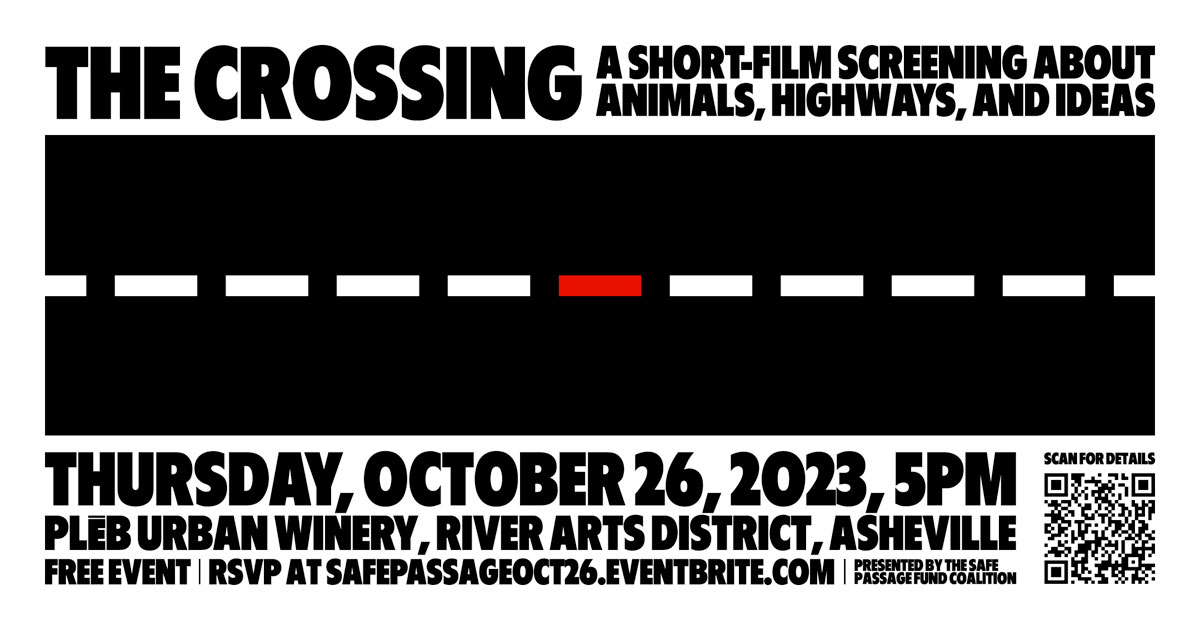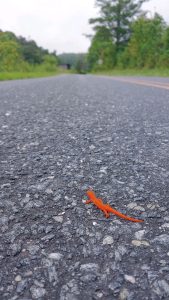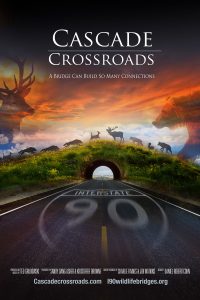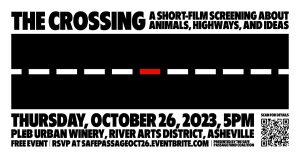
One of the great benefits and privileges of exploring Western North Carolina and East Tennessee is the opportunity to see a diverse array of wildlife wherever you go. But whether you live here or are just passing through, chances are you’ll mostly be watching the spectacle from behind a windshield.

Driving from Great Smoky Mountains National Park over the mountains to Asheville, North Carolina, this time of year, you are pretty likely to see woodchucks, wild turkey, and white-tailed deer. Perhaps you get lucky and spot a black bear and or even an elk moving through the vegetation. Look up and you may find red-tailed and broad-winged hawks and the occasional osprey or bald eagle. Watch for the smaller lifeforms too: box turtles, a variety of snakes, and even rare salamanders live right near the roadway.
“Highway travel always means risk for humans,” says filmmaker Ted Grudowski. “But roads pose an even more serious threat to wildlife, forming barriers to the habitat connectivity that is necessary for species survival. One solution has been shown to improve safety for travelers and survival of both plants and animals: wildlife crossings.”
Grudowski’s films about road ecology will be featured at The Crossing, a short-film screening coming to Asheville’s Pléb Urban Winery in the River Arts District on Thursday, October 26. The free event is presented by the Safe Passage Fund Coalition, which is working to understand where animals are getting killed in the Pigeon River Gorge between Asheville and Knoxville and how various types of wildlife crossing structures might help them cross.
“I didn’t learn about the current concept of road ecology until I began making videos about it,” says Grudowski, who will be traveling to the region from Seattle. “But I sure remember seeing a lot of roadkill on the sides of roads growing up in the Midwest. In the spring there were always dead skunks everywhere! It seemed that there were more dead than alive.”
Grudowski studied photography while attending Southern Illinois University. When he graduated, the internet and digital media were just beginning to take off.
“I went from photography to multimedia to creating short videos for an internet audience,” he says, “but the lure of making something more substantial drew me to storytelling and making short documentary films.”

Grudowski got involved with Conservation Northwest, a regional nonprofit advocating for wildlife crossings and working to restore and acquire lands adjacent to Interstate 90. He did a short video with colleague Kris Browne in 2015 highlighting a remote trail camera program in the forests of the Cascade Mountains in Washington.
“That program contributed to the realization that there was a major wildlife highway running north and south through the Cascades that was bisected by I-90,” he says. “Shortly thereafter, the coalition of nonprofits and other groups was coming to an end because the decision to incorporate the wildlife passages into the highway improvements was already made and the first leg of funding secured. They wanted to document the story of how unlikely partnerships were made in order to get the passages and road improvements to happen, and so I was approached about making Cascade Crossroads.”
Released in January 2018, Cascade Crossroads is a 30-minute documentary that chronicles a monumental project combining conservation, collaboration, and innovation that eventually led to the construction of one of North America’s largest wildlife crossing projects in conjunction with major infrastructure improvements for motorists. The film won two Telly awards in 2018, gold in the nonprofit category and bronze in the nature/wildlife category.
“When we had made the first short video, I hadn’t really grasped the depth and breadth of how incredible and unlikely it was to build the wildlife passages, as well as the implications of re-connecting the north and south Cascades with its animal highways and ecosystems,” Grudowski says. “Initially we were eager for a chance to create a longer story than we usually had the opportunity to tell, but after we began doing the background research, we all realized that there was something much bigger here unfolding, and that was very exciting.”

In 2021, Grudowski and his production team released a follow-up film, Critter Crossings in the Cascades, which was also well received.
“Making Critter Crossings was very much like doing a victory lap in a sequel, because the successful results and improvements were already tangible, so it was a chance to show the world that this project was worth all the effort to make it happen,” he says. “Cascade Crossroads had been very well received in film festivals and other public screenings, as well as winning some awards, so we knew that the public had an appetite for successful stories about helping wildlife.”
The second film also gave the team an opportunity to share the story and its success from the perspective of the Washington State Department of Transportation, which had to “create the plan for building it all, turn that plan into reality, and demonstrate to the public that this was the right thing to do. And, oh how right it was! How often do civil engineers get to be heroes?”
There have been literally thousands of animal crossings since the passages were completed and the guide fencing installed, with some unexpected animals using the passages—not just elk, deer, cougars, bears, and endangered aquatic species, but a badger and a moose as well.
Wildlife crossings have become a much bigger topic in the news since Grudowski made the first film. He is excited to visit Asheville in late October and share the success stories of the west.

“I get to come bringing good news and encouragement for your wildlife passages. I love seeing road ecology ideas taking root on that side of the country, and I’m excited to see what success stories you will write. The excitement of your community to provide and care for your own wildlife is infectious!”
When asked where he thinks the US is headed in the future in terms of road ecology, he smiles.
“People love animals, people love wildlife, and people love good news about people doing good things. It’s a counterpoint to all the bad news we are bombarded with about how people are doing things detrimental to our natural world,” he says. “The success of it all is quantifiable and undeniable. I hope it leads to a greater awareness of the natural world around us and our effect on it, and I hope it leads to accommodating wildlife becoming part of the vocabulary of all infrastructure in the United States.”
Register for The Crossing at SafePassageOct26.EventBrite.com.
Subscribe to get the latest posts sent to your email.
The Great Smokies Welcome Center is located on U.S. 321 in Townsend, TN, 2 miles from the west entrance to Great Smoky Mountains National Park. Visitors can get information about things to see and do in and around the national park and shop from a wide selection of books, gifts, and other Smokies merchandise. Daily, weekly, and annual parking tags for the national park are also available.